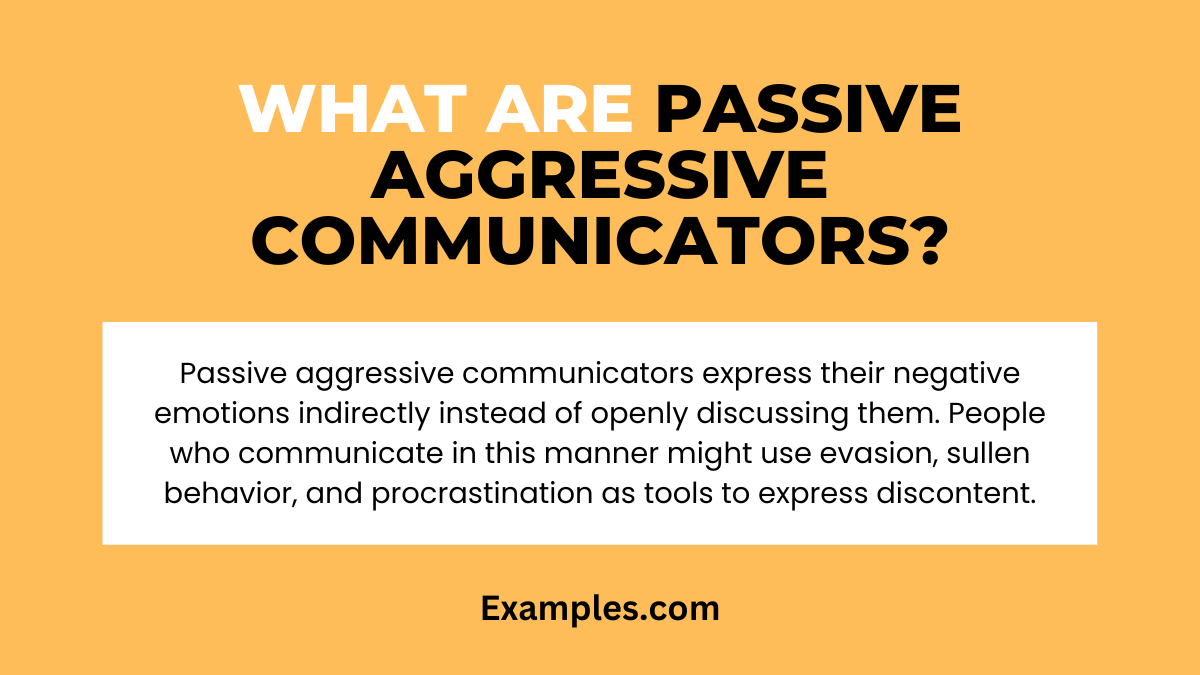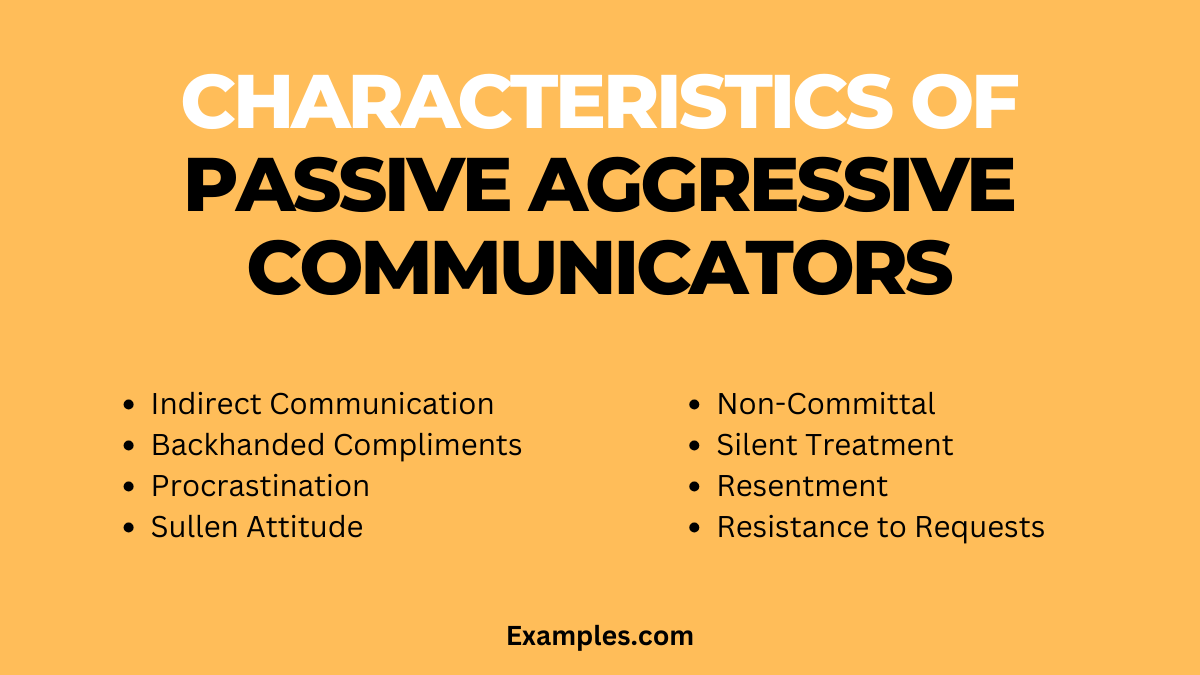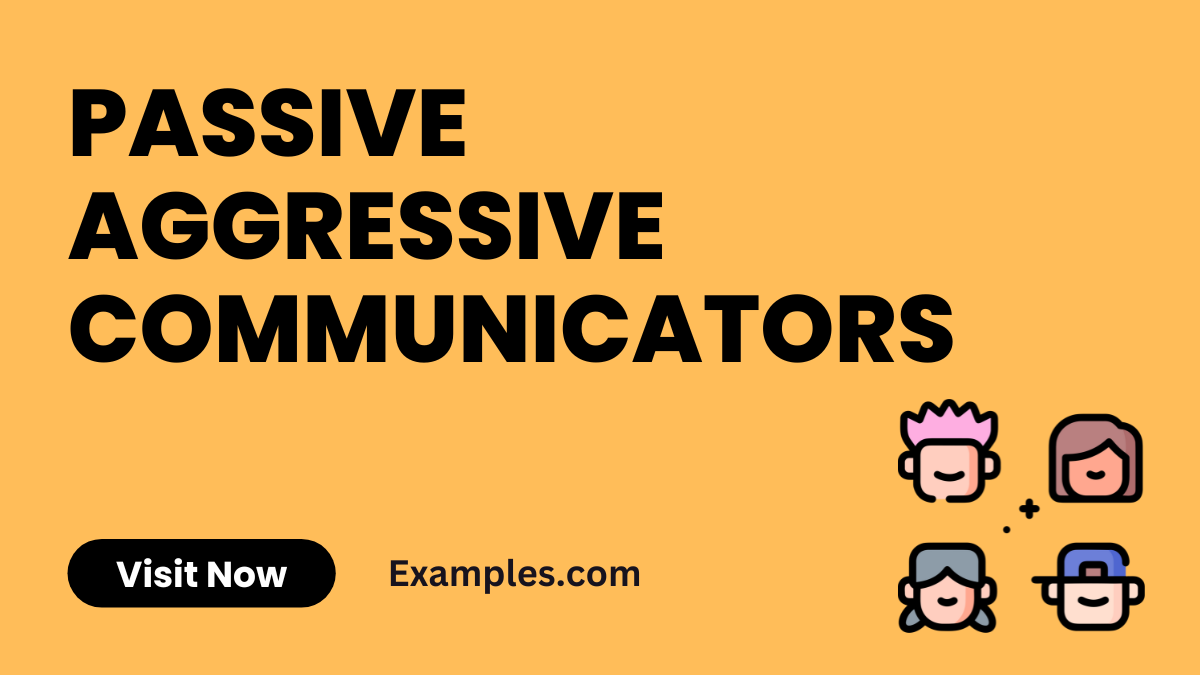29+ Passive Aggressive Communicators Examples
Passive aggressive communicators often express their negative feelings indirectly rather than confronting them head-on. This comprehensive guide delves into the subtleties of passive aggressive communication, highlighting various communication examples. Understanding this communication style is crucial for effective interaction in both personal and professional settings. The guide will explore the characteristics, underlying causes, and impact of passive aggressive communication, providing real-life examples and strategies for dealing with such communicators effectively and constructively.
What are Passive Aggressive Communicators?

Passive aggressive communicators express their negative emotions indirectly instead of openly discussing them. This communication style often involves subtle sarcasm, avoidance, and indirect criticism, making it challenging for others to understand their true feelings or intentions. People who communicate in this manner might use evasion, sullen behavior, and procrastination as tools to express discontent. Understanding this behavior is key to effectively navigating interactions with passive aggressive communicators.
What is the Best Example of a Passive Aggressive Communicator?
The best example of a passive aggressive communicator is someone who expresses negative feelings or dissatisfaction indirectly rather than openly. This might include giving backhanded compliments, using sarcasm, or procrastinating on tasks as a form of silent protest. Such communicators might agree to requests in person but then express their displeasure through their actions or lack thereof. Their communication style often leads to confusion and misunderstanding, impacting both personal and professional relationships.
30 Passive Aggressive Communicators Examples
Passive-aggressive communicators often express their negative feelings indirectly rather than stating them openly. This communication style can lead to misunderstandings and conflict in both personal and professional relationships. Recognizing and understanding passive-aggressive communication is crucial for effective interaction and conflict resolution. Here are 30 examples of passive-aggressive communicators, each with a brief explanation and example sentences, to help identify and address this challenging communication style.
- The Silent Treatment Giver: Avoids direct conversation and gives the silent treatment to express displeasure. Example: “I’m fine,” said with a cold shoulder, indicating something is wrong.
- The Sarcastic Commenter: Uses sarcasm to mask true feelings. Example: “Great job on the report,” said in a sarcastic tone, implying the opposite.
- The Complainer: Frequently complains about others without confronting them directly. Example: “Some people never do their share of work,” said in a group setting, hinting at a specific person.
- The Procrastinator: Delays tasks as a form of resistance. Example: Consistently putting off a task to show disapproval of it.
- The Backhanded Complimenter: Gives compliments that contain a hidden criticism. Example: “You’re smarter than you look.”
- The Sigher and Eye-Roller: Shows disapproval or annoyance through sighing and eye-rolling instead of verbalizing concerns.
- The Underminer: Subtly undermines others’ ideas or efforts. Example: “That’s a good start, but I’m sure you can do better.”
- The Non-Committal: Avoids giving a direct answer or commitment. Example: “Maybe, I’ll think about it,” without ever following up.
- The Gossip Spreader: Spreads rumors or talks behind people’s backs instead of addressing issues directly.
- The Forgetful One: Pretends to forget commitments or conversations to avoid responsibility.
- The Stubborn Refuser: Resists suggestions and refuses to change, often passively.
- The Exaggerator: Overstates problems to avoid direct confrontation. Example: “You always ignore my ideas.”
- The Victim Player: Portrays themselves as an innocent victim to gain sympathy or avoid confrontation.
- The Withholder: Withholds praise, information, or affection as a form of control or punishment.
- The Indirect Blamer: Blames others indirectly through hints or implications.
- The Guilt Tripper: Uses guilt to manipulate or control others’ actions. Example: “After all I’ve done for you, this is how you repay me?”
- The All-or-Nothing Thinker: Views situations in extreme terms, often as a way to shift blame.
- The Overly Polite Critic: Criticizes others under the guise of politeness. Example: “It’s so brave of you to wear that outfit.”
- The Ambiguous Speaker: Deliberately speaks in vague terms to avoid accountability.
- The Inconsistent Communicator: Sends mixed messages to confuse or manipulate the receiver.
- The Over-Apologizer: Uses excessive apologies to avoid genuine accountability or to elicit reassurance.
- The Controller: Dictates others’ actions indirectly through passive-aggressive tactics.
- The Chronic Latecomer: Habitually arrives late as a form of silent protest or control.
- The Emotional Blackmailer: Uses emotional manipulation to get their way.
- The Negative Predictor: Predicts negative outcomes as a way to discourage ideas or actions.
- The Passive Resistor: Resists new ideas or changes without openly opposing them.
- The Misinterpreter: Deliberately misinterprets communication to avoid responsibility or confrontation.
- The Indirect Insulter: Insults others in a veiled manner. Example: “It’s cute how you keep trying.”
- The Unreliable Promiser: Makes promises with no intention of keeping them.
- The Hidden Aggressor: Exhibits aggressive behavior through passive means, such as neglect or intentional inefficiency.
What are the Characteristics of Passive Aggressive Communicators?

Passive aggressive communicators exhibit behaviors that indirectly express negative feelings. They often use subtle sarcasm or backhanded compliments, and might agree verbally but their actions suggest otherwise. These individuals may resort to silent treatment or procrastination as a form of expressing discontent. Their communication tends to be ambiguous, leaving room for misinterpretation. Understanding these characteristics is key to identifying and effectively dealing with such communication:
- Indirect Communication: They express dissatisfaction in roundabout ways, avoiding direct confrontation. This can include speaking in hints or making ambiguous statements that imply discontent.
- Sarcasm and Backhanded Compliments: Their use of sarcasm or subtly insulting compliments can be a way to express negative feelings while maintaining a façade of politeness.
- Procrastination: This is often a form of silent protest or resistance, where they delay completing tasks as a way to express disapproval or frustration.
- Sullen Attitude: They may exhibit a gloomy or resentful demeanor, especially when they feel pressured or obligated.
- Non-Committal: Giving vague responses is a strategy to avoid commitment or direct answers, keeping their true intentions or opinions hidden.
- Silent Treatment: By withdrawing communication, they express anger or dissatisfaction without verbal confrontation.
- Resentment: Passive-aggressive individuals often harbor unspoken resentment, which can stem from various personal or professional reasons.
- Resistance to Requests: While appearing to agree, they may resist in subtle ways, like underperforming or consistently being late.
Recognizing these traits can help in understanding the dynamics of passive aggressive communication and navigating interactions more effectively.
How to Identify a Passive Aggressive Communicator?
Identifying a passive aggressive communicator involves noticing indirect expressions of negative emotions. They might avoid direct confrontation, expressing dissatisfaction through indirect actions like deliberate delays in tasks. Subtle cues, such as non-committal responses or using sarcasm to mask their true feelings, are common. They may also exhibit a pattern of agreeing in person but acting contrary to their agreement. Understanding these signs helps in effectively navigating interactions with such individuals. Identifying a passive aggressive communicator involves being aware of certain indicative behaviors:
- Indirect Expression of Anger: Passive-aggressive communicators frequently express anger or annoyance indirectly. This can manifest as subtle jabs, sarcastic comments, or snide remarks, often delivered in a manner that makes it difficult to directly address the underlying issue.
- Avoidance of Direct Confrontation: These individuals typically avoid face-to-face confrontations. Instead of addressing issues or conflicts openly, they express their displeasure through indirect actions or comments, making it challenging to resolve conflicts effectively.
- Inconsistency Between Words and Actions: A hallmark of passive-aggressive communication is a disconnect between what is said and what is done. For example, they might verbally agree to a request or task but then procrastinate, forget, or perform it poorly.
- Reluctance to Express Negative Emotions Openly: They often do not openly express frustration, disappointment, or dislike. Instead, these feelings are veiled in their actions or in the tone of their communication.
- Subtle Manipulation: Their interactions can include subtle forms of manipulation, such as guilt-tripping, playing the victim, or subtly coercing others to comply with their wishes without direct requests.
- Withholding of Information or Support: In workplace or personal relationships, passive-aggressive communicators may withhold crucial information or support as a form of silent protest or control. This behavior can significantly impede collaboration and trust.
- Resistance to Change: They might resist or subtly undermine efforts for change, especially if they feel threatened or insecure about the change. This resistance is often not openly discussed but is expressed through delay tactics or non-compliance.
- Victim Mentality: Passive-aggressive individuals often portray themselves as the victim of circumstances or the actions of others. This mentality serves as a defense mechanism to deflect criticism and avoid taking responsibility for their actions.
By being aware of these signs, one can better identify passive aggressive communicators and adopt strategies to manage interactions with them effectively.
Tips for Dealing with Passive Aggressive Communicators
Dealing with passive-aggressive communicators effectively involves understanding their communication style and adopting strategies that encourage open and honest dialogue:
- Stay Calm and Composed: Reacting with frustration or anger can exacerbate the situation. Maintaining a calm demeanor is crucial.
- Communicate Directly and Clearly: Use clear, direct language to express your thoughts and feelings. This helps in minimizing misunderstandings.
- Use ‘I’ Statements: Frame your responses in a way that reflects your feelings and perspective, avoiding accusatory language.
- Set and Enforce Boundaries: Clearly define your boundaries and the consequences of overstepping them.
- Encourage Open Dialogue: Create a safe space for open communication, encouraging the passive-aggressive person to express themselves more directly.
- Focus on Problem-Solving: Shift the focus from personal grievances to collaborative problem-solving.
- Seek to Understand: Show empathy and try to understand the underlying reasons for their behavior.
- Be Consistent: Consistency in your responses and expectations can help in changing their communication pattern.
Adopting these strategies can lead to more productive and less stressful interactions with passive-aggressive communicators.
In conclusion, dealing with passive-aggressive communicators effectively requires patience, clear and direct communication, and a consistent approach. By recognizing passive-aggressive traits and adopting strategies like maintaining emotional calmness, using ‘I’ statements, and encouraging open dialogue, one can navigate these challenging interactions more successfully. Understanding and empathetically responding to the underlying issues can also foster a more positive and constructive communication environment.



